What's inside
What's inside
 Key Ingredients
Key Ingredients

 Benefits
Benefits

 Concerns
Concerns

 Ingredients Side-by-side
Ingredients Side-by-side

Dimethicone
EmollientHydrogenated Polyisobutene
EmollientPolyethylene
AbrasiveTrimethyl Pentaphenyl Trisiloxane
EmollientOctyldodecyl Neopentanoate
EmollientSucrose Acetate Isobutyrate
Stearyl Heptanoate
EmollientTrimethylsiloxysilicate
EmollientStearyl Caprylate
EmollientArgania Spinosa Kernel Oil
EmollientParaffin
PerfumingPentaerythrityl Tetra-Di-T-Butyl Hydroxyhydrocinnamate
AntioxidantAlumina
AbrasiveDimethicone/Vinyltrimethylsiloxysilicate Crosspolymer
Cera Microcristallina
Emulsion StabilisingSynthetic Wax
AbrasiveCalcium Sodium Borosilicate
Citronellol
PerfumingCalcium Aluminum Borosilicate
Synthetic Fluorphlogopite
CI 77120
Cosmetic ColorantLimonene
PerfumingColophonium
Geraniol
PerfumingMagnesium Silicate
AbsorbentSilica
AbrasiveBenzyl Alcohol
PerfumingTocopherol
AntioxidantLinalool
PerfumingTin Oxide
AbrasiveAluminum Hydroxide
EmollientParfum
MaskingCI 77891
Cosmetic ColorantCI 77491
Cosmetic ColorantCI 77492
Cosmetic ColorantCI 77499
Cosmetic ColorantCI 15850
Cosmetic ColorantCI 45410
Cosmetic ColorantCI 15985
Cosmetic ColorantCI 42090
Cosmetic ColorantCI 17200
Cosmetic ColorantCI 45380
Cosmetic ColorantCI 77742
Cosmetic ColorantCI 75470
Cosmetic ColorantCI 19140
Cosmetic ColorantDimethicone, Hydrogenated Polyisobutene, Polyethylene, Trimethyl Pentaphenyl Trisiloxane, Octyldodecyl Neopentanoate, Sucrose Acetate Isobutyrate, Stearyl Heptanoate, Trimethylsiloxysilicate, Stearyl Caprylate, Argania Spinosa Kernel Oil, Paraffin, Pentaerythrityl Tetra-Di-T-Butyl Hydroxyhydrocinnamate, Alumina, Dimethicone/Vinyltrimethylsiloxysilicate Crosspolymer, Cera Microcristallina, Synthetic Wax, Calcium Sodium Borosilicate, Citronellol, Calcium Aluminum Borosilicate, Synthetic Fluorphlogopite, CI 77120, Limonene, Colophonium, Geraniol, Magnesium Silicate, Silica, Benzyl Alcohol, Tocopherol, Linalool, Tin Oxide, Aluminum Hydroxide, Parfum, CI 77891, CI 77491, CI 77492, CI 77499, CI 15850, CI 45410, CI 15985, CI 42090, CI 17200, CI 45380, CI 77742, CI 75470, CI 19140
Sorbitan Isostearate
EmulsifyingIsocetyl Stearate
EmollientPhenyl Trimethicone
Skin ConditioningPolyethylene
AbrasiveEuphorbia Cerifera Wax
Butyrospermum Parkii Butter Unsaponifiables
Skin ConditioningBeeswax
Emulsion StabilisingSimmondsia Chinensis Seed Oil
EmollientCaprylic/Capric Triglyceride
MaskingNylon-12
Octyldodecanol
EmollientPolyglyceryl-2 Diisostearate
EmulsifyingSilica
AbrasiveCopernicia Cerifera Wax
Hydrogenated Coconut Oil
EmollientTocopherol
AntioxidantVp/Hexadecene Copolymer
Stearalkonium Hectorite
Gel FormingStearyl Glycyrrhetinate
Skin ConditioningPropylparaben
PreservativePropylene Carbonate
SolventSorbitan Isostearate, Isocetyl Stearate, Phenyl Trimethicone, Polyethylene, Euphorbia Cerifera Wax, Butyrospermum Parkii Butter Unsaponifiables, Beeswax, Simmondsia Chinensis Seed Oil, Caprylic/Capric Triglyceride, Nylon-12, Octyldodecanol, Polyglyceryl-2 Diisostearate, Silica, Copernicia Cerifera Wax, Hydrogenated Coconut Oil, Tocopherol, Vp/Hexadecene Copolymer, Stearalkonium Hectorite, Stearyl Glycyrrhetinate, Propylparaben, Propylene Carbonate
 Reviews
Reviews

Ingredients Explained
These ingredients are found in both products.
Ingredients higher up in an ingredient list are typically present in a larger amount.
Polyethylene is a synthetic ingredient that helps the skin retain moisture. It is a polymer.
It is also typically used within product formulations to help bind solid ingredients together and thicken oil-based ingredients. When added to balms and emulsions, it helps increase the melting point temperature.
Silica, also known as silicon dioxide, is a naturally occurring mineral. It is used as a fine, spherical, and porous powder in cosmetics.
Though it has exfoliant properties, the function of silica varies depending on the product.
The unique structure of silica enhances the spreadability and adds smoothness, making it a great texture enhancer.
It is also used as an active carrier, emulsifier, and mattifier due to its ability to absorb excess oil.
In some products, tiny microneedles called spicules are made from silica or hydrolyzed sponge. When you rub them in, they lightly polish away dead skin layers and enhance the penetration of active ingredients.
Learn more about SilicaTocopherol (also known as Vitamin E) is a common antioxidant used to help protect the skin from free-radicals and strengthen the skin barrier. It's also fat soluble - this means our skin is great at absorbing it.
Vitamin E also helps keep your natural skin lipids healthy. Your lipid skin barrier naturally consists of lipids, ceramides, and fatty acids. Vitamin E offers extra protection for your skin’s lipid barrier, keeping your skin healthy and nourished.
Another benefit is a bit of UV protection. Vitamin E helps reduce the damage caused by UVB rays. (It should not replace your sunscreen). Combining it with Vitamin C can decrease sunburned cells and hyperpigmentation after UV exposure.
You might have noticed Vitamin E + C often paired together. This is because it is great at stabilizing Vitamin C. Using the two together helps increase the effectiveness of both ingredients.
There are often claims that Vitamin E can reduce/prevent scarring, but these claims haven't been confirmed by scientific research.
Learn more about Tocopherol